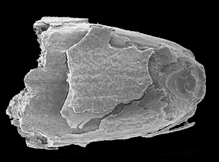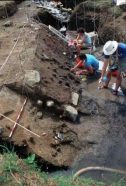Traces of Ancient Campfires
Researchers have unearthed traces of what may be among the oldest human-controlled fires.
By Emily Sohn
It’s hard to imagine going on a camping trip without a reliable source of fire. After all, how would you stay warm or cook your food?
Our prehistoric ancestors probably realized the importance of fire long ago. New research suggests that inhabitants of an area near a lake in what’s now northern Israel may have built fires in hearths as early as 750,000 years ago. If so, it would be the oldest known example in Asia or Europe of humans controlling fire.
 |
|
Microscopic view of a burned grain of goat grass found at a Stone Age location in Israel. |
| Naama Goren-Inbar |
The evidence comes from clusters of flint fragments that have burn marks on them. The researchers, who are from Hebrew University in Jerusalem, suggest that the objects lie where an ancient population had built hearths. Nearby, the scientists also found burned seeds and charred pieces of wood.
Animal bones and other clues in the area allowed the scientists to estimate the age of the remains. It looks like the area’s inhabitants started making hearths nearly 790,000 years ago and continued doing so for 100,000 years.
 |
|
Excavation site in Israel where traces of ancient hearths were found. |
| © Science |
These ancient people probably used fire to make heat, prepare food, and keep predators away, the researchers say.
Inhabitants of the Israeli site may not have been the first ones to make and keep fire, however. Some scientists have proposed that our prehistoric ancestors in Africa started using fire more than 1 million years ago.
The new find is consistent with the idea that fire-keeping started in Africa before spreading to other parts of the world. Consider that the next time you savor a flame-broiled burger!—E. Sohn
Going Deeper:
Bower, Bruce. 2004. Stone Age combustion: Fire use proposed at ancient Israeli site. Science News 165(May 1):276. Available at http://www.sciencenews.org/articles/20040501/fob3.asp .







